Cypriot euro coins facts for kids
Cypriot euro coins have special designs that tell stories about Cyprus. Cyprus joined the European Union on May 1, 2004. Then, on January 1, 2008, it officially started using the euro as its money, replacing its old currency.
Contents
Designs on Cypriot Euro Coins
Each Cypriot euro coin has a unique design on one side, showing something important about the island. The other side of the euro coins looks the same across all countries that use the euro.
| 1¢ | 2¢ | 5¢ |
|---|---|---|
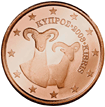 |
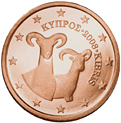 |
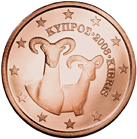 |
| The mouflon, a wild sheep found in Cyprus. | ||
| 10¢ | 20¢ | 50¢ |
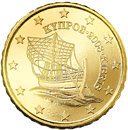 |
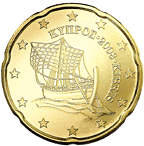 |
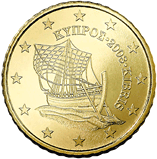 |
| The Kyrenia ship, an ancient Greek shipwreck. | ||
| €1 | €2 | € 2 Coin Edge |
 |
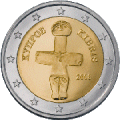 |
|
| The Idol of Pomos, an ancient statue. | ||
What the Designs Mean
- 1, 2, and 5 cent coins: These coins show the mouflon. This is a type of wild sheep that lives in Cyprus. It represents the island's beautiful nature and wildlife.
- 10, 20, and 50 cent coins: These coins feature the Kyrenia ship. This was an ancient Greek ship from around 400 B.C. It shows Cyprus's long history and its importance as an island for trade.
- €1 and €2 coins: These coins display the Idol of Pomos. This is a very old, cross-shaped statue from about 3000 B.C. It was found in a village called Pomos. It represents Cyprus's ancient culture and art.
How Many Coins Are Made?
The table below shows how many Cypriot euro coins were made each year for different values. This is called the "mintage quantity."
| Coin Value | €0,01 | €0,02 | €0,05 | €0,10 | €0,20 | €0,50 | €1,00 | €2,00 |
|---|---|---|---|---|---|---|---|---|
| 2008 | 40 000 000 | 100 000 000 | 60 000 000 | 70 000 000 | 65 000 000 | 30 000 000 | 28 000 000 | 25 000 000 |
| 2009 | 20 000 000 | 1 000 000 | 6 000 000 | 1 000 000 | 1 000 000 | 1 000 000 | 4 000 000 | 5 000 000 |
| 2010 | 200 000 | 200 000 | 200 000 | 200 000 | 200 000 | 200 000 | 200 000 | 200 000 |
| 2011 | 15 210 000 | 210 000 | 30 210 000 | 210 000 | 210 000 | 210 000 | 210 000 | 210 000 |
| 2012 | 210 000 | 210 000 | 1 000 000 | 1 000 000 | 1 000 000 | 1 000 000 | 1 000 000 | 1 000 000 |
| 2013 | 100 000 | 100 000 | 100 000 | 100 000 | 100 000 | 100 000 | 100 000 | 100 000 |
| 2014 | 100 000 | 100 000 | 100 000 | 100 000 | 100 000 | 100 000 | 100 000 | 100 000 |
| 2015 | 7 100 000 | 100 000 | 100 000 | 100 000 | 100 000 | 100 000 | 100 000 | 100 000 |
| 2016 | 8 000 000 | 100 000 | 100 000 | 100 000 | 100 000 | 100 000 | 100 000 | 100 000 |
| 2017 | 100 000 | 100 000 | 100 000 | 100 000 | 100 000 | 100 000 | 100 000 | 100 000 |
| 2018 | 100 000 | 100 000 | 100 000 | 100 000 | 100 000 | 100 000 | 100 000 | 100 000 |
Where the Coins Are Made
- From 2008 to 2020, Cypriot euro coins were made in Finland.
- From 2010 to 2018, they were made in Greece.
Special Marks on Coins
Euro coins have certain marks to show where they are from or who designed them.
| What it is | Cypriot Euro Mark |
| Country Name | "ΚΥΠΡΟΣ (Kypros) and KIBRIS" (These are "Cyprus" in Greek and Turkish) |
| Mint Mark | None (Cypriot coins don't have a special mark from the mint where they were made) |
| Designer's Initials | None (You won't find the initials of the artists who designed the coins) |
| €2 Edge Writing |
Choosing the Designs
Cyprus held a public contest to pick the designs for its euro coins. This contest ended on October 14, 2005. The rules for the contest said what each coin should show:
- The mouflon for the 1, 2, and 5 cent coins.
- The Kyrenia ship for the 10, 20, and 50 cent coins.
- The Idol of Pomos for the €1 and €2 coins.
Two artists, Erik Maell from America and Tatiana Soteropoulos from Greece, were chosen to create these designs. They were told to include the name of Cyprus in both Greek (ΚΥΠΡΟΣ) and Turkish (KIBRIS) on the coins.
Cyprus Joins the Euro
Here's a quick timeline of how Cyprus adopted the euro:
- October 11, 2006: The final designs for the coins were shown at an exhibit. They included "Cyprus" in Greek and Turkish, but not in English.
- February 13, 2007: Cyprus officially asked to join the eurozone (the group of countries using the euro) by January 1, 2008.
- March 9, 2007: A campaign started in Cyprus to teach people about the euro.
- March 15, 2007: The Cypriot government passed the laws needed to start using the euro.
- May 16, 2007: A European Union official recommended that Cyprus adopt the euro as planned.
- June 20-21, 2007: The European Parliament and EU leaders agreed that Cyprus could join the euro.
- July 10, 2007: EU Finance Ministers set the official exchange rate: 1 euro was equal to 0.585274 Cypriot pounds.
- October 23, 2007: The coin designs were officially published.
- January 1, 2008: The euro became the official money in Cyprus, replacing the Cypriot pound.
Special Collector's Coins
Even though Cyprus joined the Eurozone in 2008, they had already made some special, high-value coins from silver. These coins are called "commemorative coins." They are usually made to celebrate an event or person. These coins are mostly for collectors and are not meant to be used for everyday shopping.
See also
- Cyprus in the European Union

